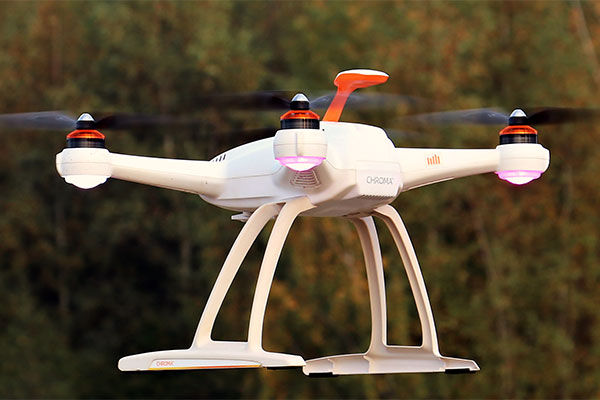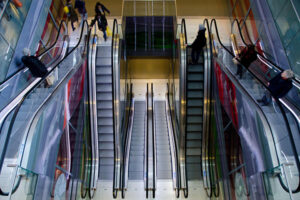By Thomas Seikmann
The development towards an entirely new world will exponentially increase in speed in a very short period of time and will present us with the most far-reaching changes in history. In the past, this was always the case. The difference this time is that man will not be able to keep up with the development.
Shopping won’t culminate in delivery via drones. There will be automated 3D printing systems in our homes, printing and assembling tailor-made products on site, then handing them over to us. This will affect the majority of basic consumer goods. All of this will be done at an unprecedented speed, tailored to your needs, and at a reasonable price.

Terminal devices will be programmed by computers, and people will only act as consumers. Shopping centers, in their current form, are undergoing a radical transformation, shifting away from satisfying demand to providing social meeting places. Virtual spaces, hologram worlds, and full-body suits that will enable us to physically experience and perceive distant places will dominate the future.
Communication with online stores will primarily be facilitated via omniscient chatbots, which will provide any information related to the goal and sequence of the solution. This will generally apply to the vast majority of communication in professional life and service facilities in private households. Comparatively, the industrial revolution will be regarded as a minor evolution.
Food production will be carried out in climatic chambers located in kitchens. Various cell structures, such as meat and fish, will be grown on glass panels via cell reproduction, commercial animal husbandry will cease to exist, and animal slaughter will no longer be necessary. Those items requiring delivery will be deposited in climatic chambers at building entrances by self-driving cars or drones that will automatically be given access.
Shopping centers are being completely revamped and transformed into pure exhibition areas featuring the latest trends and products, social meeting places, and entertainment worlds. Customers and target groups will be redefined in terms of age profiles as a result of the major medical advancements towards eternal life. This only represents a modest selection of world-changing innovations. Figuratively speaking, these developments will not occur tomorrow, but the day after tomorrow. The question to be answered is how this scenario will be achieved and how it will affect existing structures.
Retail
The number of shops will be reduced as will shop sizes. Initially, this will affect industries such as electrical stores and furniture stores, but, subsequently, it will affect all others as well. The fashion industry, which currently depends on customers’ desire to try on clothes, will also be affected as body screenings and the resulting custom-fit individual productions will soon render trying on clothes obsolete. The shop itself will increasingly serve as an exhibition space and will only possess a presentational character.
Outlet centers, some of which serve as clearing houses for online trading, are experiencing a counter-movement. Megastores are being built there, at least for the time being. Outlets can compete with the price reductions seen in online retail and, as a bonus, are positioned as destinations for experience shopping outings and leisure activities by way of bargain hunting. Many outlets are currently connected to neighboring recreational parks. This trend will continue to gain momentum.
Shopping Center
Full-price shopping centers will increasingly be built below residential complexes in city centers or district centers, or existing centers will be expanded or supplemented by residential complexes on the floors above them – if possible – or otherwise replaced by new hybrid projects. These centers will function less as shopping centers, from which purchased goods are immediately taken home, but more as social meeting places offering entertainment facilities, restaurants, showrooms, sports and fitness facilities, and mobile workplaces.

Transport
Parking garages will gradually vanish, as self-driving cars will drop passengers off at their desired points and continue driving; they will also park and recharge outside of cities at night, for the most part. Moreover, those areas will be required by the logistics departments to fulfill online order delivery guarantees.
Employees
Employees continuously receive further training. However, it should be assumed that these employees will gradually be replaced by humanoid robotic systems. Costs incurred as a result of sales and consulting personnel will be massively reduced. They counteract a complete shift in the direction of online retailing by reducing the growing cost advantage of online retailing due to the automation of logistics. In addition, these humanoid robotic systems are virtually omniscient and can provide all kinds of information about products in a socially acceptable form of communication.
Gastronomy
Gastronomy will mainly consist of system gastronomy, which will also offer the entire product range as culinary boxes or home deliveries. Orders will be placed via smartphones or their successors, such as skin implants equipped with hologram projections. Here, too, humanoid robotic systems will serve us. These will reduce the cost of the human factor and, thus, strengthen the trend towards gastronomy as consumption outside the home moves closer in price to in-house production at home via gastronomy chain systems that offer automated production and service.
Products
If items are not in stock or are not available, they will be produced to order and delivered immediately. Consumption will become more personalized. The systems will keep track of the special requirements of each individual consumer and will make them available worldwide.
Customers
The age profile of customers will change. Enormous progress will be made in the medical field with regard to life expectancy via automated health care systems using mini robots that circulate in our blood and repair and/or renew cells, facilitating almost unlimited life expectancy. Entirely new consumer categories are thus created and, like others whose chores are taken over by robots, they have a lot of free time. Income will be provided by the state in order to keep the economic cycle alive. The extent to which this can be implemented will become apparent, as will the effects of possible civil wars and revolts by those who do not participate sufficiently.
Residential Areas
Residential areas will become more and more dense and prices will explode, leading to increasingly smaller apartments. This will increase the demand for external communal areas, such as former traditional shopping centers, temporary homes, and hotels. In addition, multi-story farms for food production will be built, some of them directly next to the residential buildings, with final maturation taking place in climatic chambers in restaurant or home kitchens.
Production Facilities
Production facilities will migrate back from low-wage countries due to automation. This trend will start in the electronics and fashion industries and result in deserted factories. Linking of the systems along with robotic automation will reduce production costs. The human price-driving factor will be eliminated.
Summary
Brick-and-mortar retail will undergo a complete change. The temples will change, too, but they will not disappear. The forthcoming modifications will prove particularly challenging, especially in terms of timing, as the old structures undoubtedly yield better returns. If, however, one moves too late or too slowly, the survival of the site itself may be endangered.
About the Author

Thomas Seikmann is Managing Director of Parndorf Fashion Outlet, Freeport Fashion Outlet, and the Dayland Group.






